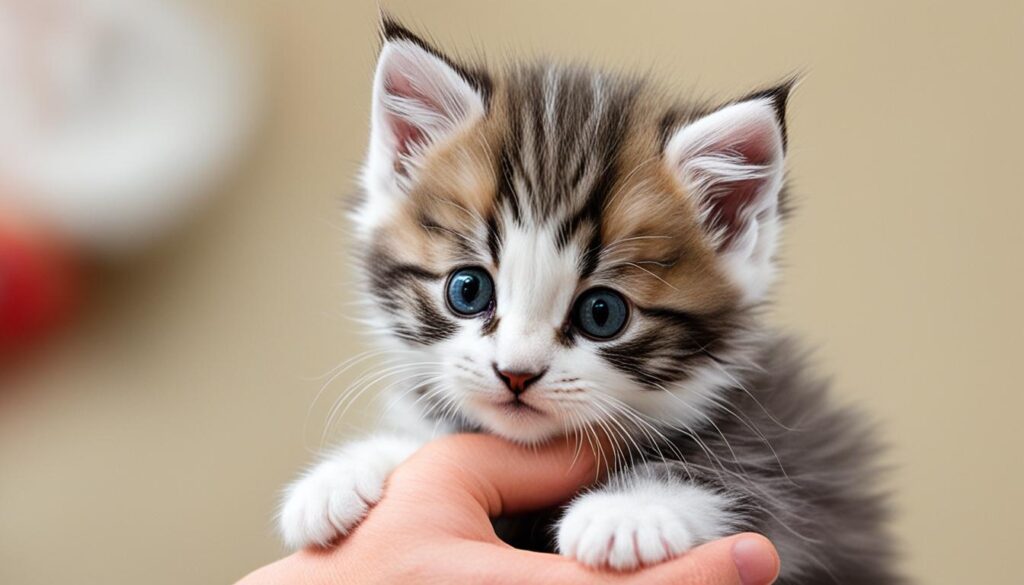As an Amazon Associate I earn from qualifying purchases.
Hey there, fellow feline enthusiast! Have you recently welcomed a precious new furball into your home? Congratulations! As a proud cat parent myself, I know the joy and excitement that comes with bringing a kitten into your life. But amidst all the cuddles and playtime, there’s one question that often comes to mind – is your furry bundle of joy a boy or a girl?
Figuring out the gender of a kitten can sometimes be a tricky task, especially for first-time cat parents. But worry not, because I’m here to guide you through the process and help you make an educated assessment. So, let’s dive right in and discover the telltale signs that reveal whether your adorable kitten is a male or a female.
“A picture purr-fectly capturing the essence of kitten gender identification.”
Other Clues for Determining Kitten Gender
When it comes to sexing kittens, visual inspection is one method, but there are also other clues you can look out for to determine the gender of your furry friends. As kittens grow older, behavioral differences may start to emerge that can help you distinguish male and female kittens. Male kittens tend to become more territorial and may exhibit a tendency to roam, exploring their surroundings. On the other hand, female kittens may go into heat at a young age, which can manifest in behaviors such as vocalization and increased affection seeking.
Not only can behavior give you a hint about a kitten’s gender, but their coat color can also provide valuable insight. Most calico or tortoiseshell cats are female, while orange or ginger-colored cats are more often male. These color patterns are influenced by genetics, with the distinctions arising from the presence or absence of certain genes.
Let’s take a closer look at these clues:
| Clue | Possible Indicators |
|---|---|
| Behavior | Male kittens may become more territorial and prone to roaming. Female kittens may go into heat at a young age, exhibiting behaviors like vocalization and increased affection seeking. |
| Coat Color | Calico or tortoiseshell patterns often indicate a female kitten, while orange or ginger-colored cats are more commonly male. |
By paying attention to these additional clues, you can enhance your ability to determine the gender of your kittens. However, it’s important to note that these methods are not foolproof, and professional confirmation from a veterinarian is always recommended.
Stay tuned for Section 3, where we’ll explain how to safely assess kitten gender with expert tips and considerations.
How to Safely Assess Kitten Gender
When it comes to determining the gender of kittens, it’s important to handle them with care and minimize stress. You should wait until the kittens are at least two weeks old before beginning the gender assessment process. Here are some steps to safely assess the gender of your kittens:
- Pick them up: Gently pick up the kittens and hold them close to your body. This will help them feel secure and comfortable.
- Pet and snuggle: Stroke their fur and provide gentle petting to help them relax and bond with you.
- Scratch their back: Lightly scratch their back near the base of the tail. This may cause them to lift their tails, giving you a better view of their genital area.
- Observe genital area: Take a careful look at the area beneath the tail. Look for the specific characteristics that indicate the kitten’s gender.
While these steps can help you in determining the gender of the kittens, it’s important to note that some kittens may be panicky or standoffish during this process. In such cases, it’s best to postpone the inspection to a later date when they are more relaxed and receptive.
Remember, accurate gender identification is crucial for their health and well-being. With these safe assessment techniques, you can confidently identify whether your kittens are male or female.

| Male Kittens | Female Kittens |
|---|---|
| Wide spacing between anus and penis | Anus and vaginal opening close together |
| Penis appears as a circle below the anus | Vaginal opening resembles a vertical slit or teardrop shape |
| Testes may be felt as small, oval-shaped objects under the skin | Coat color may vary, but tricolor cats are usually female |
Factors to Consider When Gendering Kittens
While determining the gender of a kitten is generally reliable, there can be exceptions and variations that make the process more complex. Some kittens may exhibit genitalia that resemble punctuation marks, providing additional clues to their gender. For example, a female kitten may have an upside-down exclamation point shape, while a male kitten may have a colon shape. However, it’s important to note that not all kittens will have these distinct characteristics.
When it comes to distinguishing male and female kittens, there are other factors to consider. Coat color can sometimes provide hints, as certain patterns are more common in one gender over the other. Additionally, observing behavior differences as the kittens grow older can also be informative. Male kittens may become more territorial and inclined to roam, while female kittens may exhibit signs of going into heat at a young age.
While these factors can help in determining the gender of a kitten, it’s always best to consult with a veterinarian for professional confirmation. They have the expertise and experience to provide accurate assessments and can perform more thorough examinations if necessary.
Example of Kitten Gender Characteristics
| Kitten | Gender Characteristics |
|---|---|
| Male | – Colon-shaped genitalia |
| Female | – Upside-down exclamation point-shaped genitalia |
Note: Not all kittens will exhibit these distinct genitalia characteristics. Use this table as a general reference and consult with a veterinarian for accurate gender confirmation.

Conclusion
Decoding the gender of your adorable kitten can be quite a puzzle, but fear not, feline enthusiasts! By methodically examining their genitalia, paying attention to coat colors, and considering behavioral patterns, you can make an educated guess about whether your furry friend is a boy or girl. However, keep in mind that gender identification is not foolproof. Sometimes, tiny variations and exceptions can make it tricky to be certain.
That’s where the expert advice of a veterinarian comes in. For an accurate and professional confirmation of your kitten’s gender, it’s always wise to consult with a trusted veterinary professional. They have the expertise and experience to provide you with the qualified guidance you need, putting any lingering doubts to rest.
In the end, understanding the gender of your kitten is a fascinating journey that deepens your bond with your furry companion. So, put on your detective hat, observe those tail areas keenly, and have fun unraveling the mystery of your kitten’s gender. And remember, no matter if your kitten ends up being a little lady or a dashing gentleman, their gender doesn’t change the abundance of love and joy they’ll bring into your life. Happy kitten parenting!
FAQ
How can I tell if my kitten is male or female?
Are there other clues to help determine the gender of a kitten?
How do I safely assess the gender of a kitten?
What factors should I consider when trying to determine the gender of kittens?
Is it difficult to tell if a kitten is male or female?
Source Links
- https://www.thesprucepets.com/telling-the-sex-of-kittens-555173
- https://humanepro.org/magazine/articles/fact-sheet-how-determine-kittens-sex
- https://hospital.vetmed.wsu.edu/2021/11/17/determining-gender-sex-of-a-kitten/
As an Amazon Associate I earn from qualifying purchases.

